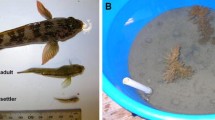Summary
Reefs dominated by red algae, associated with high echinoid densities, are consistent features of the shallow subtidal around northeastern New Zealand. Factors determining the abundance of juvenile Evechinus chloroticus were investigated in such a habitat. Using a factorial design, a field experiment was used to assess the influence of predators and adult E. chloroticus on juvenile abundance. The use of 2 m2 exclusion cages enhanced juvenile E. chloroticus abundance over a 16 month period, an effect independent of conspecific adults. We attributed this effect to the exclusion of benthic-feeding, predatory fish. Several species forage over the study area at high densities and are known from gut content analysis to prey on juvenile E. chloroticus in the field. Invertebrate predators are at very low densities in the area. The possibility of caging and site artefacts confounding this interpretation is discussed.
Adult E. chloroticus did not directly affect conspecific juvenile densities during the experimental period. However their removal produced a significant change in community structure toward one dominated by macroscopic brown algae. Echinoid removal led to rapid recruitment of laminarian and fucoid algae, predominantly Ecklonia radiata and Sargassum sinclairii. In addition, densities of herbivorous gastropods, particularly the limpet Cellana stellifera decreased in the echinoid exclusion area, as did the feeding rates of predatory fish. The consequences of E. chloroticus removal may be dependent upon the size of the area from which they are excluded.
Despite the high densities of predatory fish, a low though consistent number of juvenile E. chloroticus escape predation. We suggest that these represent sufficient input into the adult grazing population to maintain the habitat. This interpretation argues against a key role for predators in structuring shallow water reef communities in northeastern New Zealand.
Similar content being viewed by others
References
Ayling AM (1981) The role of biological disturbance in temperate subtidal encrusting communities. Ecology 62:830–847
Bernstein BB, Williams BE, Mann KH (1981) The role of behavioural responses to predators in modifying urchins' (Strongylocentrotus droebachiensis) destructive grazing and seasonal foraging patterns. Mar Biol 63:39–49
Breen PA, Mann KH (1976) Changing lobster abundance and the destruction of kelp beds by sea urchins. Mar Biol 34:137–142
Cameron RA, Schroeter SC (1980) Sea urchin recruitment: effect of substrate selection on juvenile distribution. Mar Ecol Prog Ser 2:243–247
Chapman ARO (1981) Stability of sea urchin dominated barren grounds following destructive grazing of kelp in St. Margaret's Bay, eastern Canada. Mar Biol 62:307–311
Choat JH, Schiel DR (1982) Patterns of distribution and abundance of large brown algae and invertebrate herbivores in subtidal regions of northern New Zealand. J Exp Mar Biol Ecol 60:129–162
Duggins DO (1980) Kelp beds and sea otters: an experimental approach. Ecology 61:447–453
Ebert TA (1967) Negative growth and longevity in the purple sea urchin Strongylocentrotus purpuratus (Stimpson). Science 157:557–558
Ebert TA (1968) Growth rates of the sea urchin Stronglyocentrotus purpuratus related to food availability and spine abrasion. Ecology 49:1075–1091
Ebert TA (1977) An experimental analysis of sea urchin dynamics and community interactions on a rock jetty. J Exp Mar Biol Ecol 29:1–22
Foreman RE (1977) Benthic community modification and recovery following intensive grazing by Strongylocentrotus droebachiensis. Helgolander Wiss Meeresunters 30:468–484
Jones GP (1980) Interrelationships between ecology, behaviour and life history in the protogynous hermaphrodite Pseudolabrus celidotus (Pisces: Labridae). Thesis, University of Auckland, Auckland, New Zealand
Jones GP (1981) Spawning site choice by female Pseudolabrus celidotus (Pisces: Labridae) and its influence on the mating system. Behav Ecol Sociobiol. 8:129–142
Kingett PD, Choat JH (1981) An analysis of density and distribution patterns in Chrysophrys auratus (Pisces: Spariadae) within a reef environment: an experimental approach. Mar Ecol Prog Ser 5:283–290
Lang C, Mann KH (1976) Changes in sea urchin populations after the destruction of kelp beds. Mar Biol 36:321–326
Lawrence J (1975) On the relationship between marine plants and sea urchins. Mar Biol Ann Rev 13:213–286
Leum LL, Choat JH (1980) Density and distribution patterns of the temperate marine fish Cheilodactylus spectabilis (Cheilodactylidae) in a reef environment. Mar Biol 57:327–337
Mann KH (1977) Destruction of kelp beds by sea urchins: a cyclical phenomenon or irreversible degradation? Helgolander Wiss Meeresunters 30:455–467
Muntz L, Ebling FJ, Kitching JA (1965) The Ecology of Lough Ine. XIV. Predatory activity of large crabs. J Anim Ecol 34:315–329
North WJ, Pearse JS (1970) Sea urchin population explosion in southern California coastal waters. Science 167:209
Paine RT, Vadas RL (1969) The effects of grazing by sea urchins Strongylocentrotus spp., on benthic algal populations. Limnol Oceanogr 14:710–719
Pearse JS, Costa DP, Yellin MB, Agegian CR (1977) Localized mass mortality of red sea urchin Strongylocentrotus franciscanus, near Santa Cruz, California. Fish Bull 75:645–648
Poynter MR (1980) The distribution and abundance of a temperate reef fish Parika scaber (Monocanthidae) with emphasis on recruitment, plus aspects of feeding ecology and growth. MSc Thesis, University of Auckland, Auckland, New Zealand
Russell BC (1971) Ecological relationships of rocky reef fishes of northeastern New Zealand. MSc Thesis University of Auckland, Auckland, New Zealand
Snedecor GW, Cochran WG (1980) Statistical methods. (7th edition). The Iowa State University Press, pp 507
Tegner M, Dayton P (1977) Sea urchin recruitment patterns and implications of commercial fishing. Science 196:324–326
Tegner M, Dayton P (1981) Population Structure, Recruitment and Mortality of two sea urchins (Strongylocentrotus franciscanus and S. purpuratus) in a Kelp Forest. Mar Ecol Prog Ser 5:255–268
Walker M (1977) Local variation in the population biology of Evechinus chloroticus (Valenciennes). MSc Thesis University of Auckland, Auckland, New Zealand
Author information
Authors and Affiliations
Rights and permissions
About this article
Cite this article
Andrew, N.L., Choat, J.H. The influence of predation and conspecific adults on the abundance of juvenile Evechinus chloroticus (Echinoidea:Echinometridae). Oecologia 54, 80–87 (1982). https://doi.org/10.1007/BF00541113
Received:
Issue Date:
DOI: https://doi.org/10.1007/BF00541113




